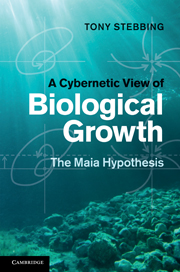Book contents
- Frontmatter
- Contents
- Foreword by Ernest Naylor
- Preface: ‘A fragment of a possible world’
- Acknowledgements
- 1 Introduction
- 2 Growth unlimited: blooms, swarms and plagues
- 3 Self-regulating systems: from machines to humans
- 4 The wealth of homeodynamic responses
- 5 A cybernetic approach to growth analysis
- 6 A control mechanism for Maia
- 7 The three levels of adaptation
- 8 Population growth and its control
- 9 Hierarchy: a controlled harmony
- 10 History of hormesis and links to homeopathy
- 11 Maian mechanisms for hormesis and catch-up growth
- 12 Cellular growth control and cancer
- 13 Human overpopulation
- 14 Our finite Earth
- 15 The Maia hypothesis and anagenesis
- Glossary
- Further reading
- References
- Index
9 - Hierarchy: a controlled harmony
Published online by Cambridge University Press: 10 January 2011
- Frontmatter
- Contents
- Foreword by Ernest Naylor
- Preface: ‘A fragment of a possible world’
- Acknowledgements
- 1 Introduction
- 2 Growth unlimited: blooms, swarms and plagues
- 3 Self-regulating systems: from machines to humans
- 4 The wealth of homeodynamic responses
- 5 A cybernetic approach to growth analysis
- 6 A control mechanism for Maia
- 7 The three levels of adaptation
- 8 Population growth and its control
- 9 Hierarchy: a controlled harmony
- 10 History of hormesis and links to homeopathy
- 11 Maian mechanisms for hormesis and catch-up growth
- 12 Cellular growth control and cancer
- 13 Human overpopulation
- 14 Our finite Earth
- 15 The Maia hypothesis and anagenesis
- Glossary
- Further reading
- References
- Index
Summary
The actual organization of living systems into sub-cellular organelles, organs, organisms, populations, species and so forth is analogous to a hierarchy of control mechanisms.
A.A. LyapunovA theory of multi-level systems is indispensable for making any progress in understanding complex organizations.
M.D. MesarovicReductionism means you turn a blind eye to the higher functions of hierarchy, the emergent properties of hierarchy, the goals and purposes of hierarchy.
Douglas HofstadterWhere there is the need for a controller, a controller of the controller is also needed.
Tadeusz KotarbinskiWHAT IS A NESTED HIERARCHY?
Animals are immensely complex and their ordering in a hierarchical manner, with a number of levels of organisation, is what helps make their understanding possible. It is almost as if life was structured as a hierarchy so as to divide up biology for the convenience of those who study it. Thus we have molecules, organelles, cells, tissues and organisms, each of which is a specialist area for different kinds of biologists, who observe the distinction between levels of biological organisation as the boundaries to their own disciplines. This is convenient, as different specialists require different technologies related to the scale and level in the hierarchy at which they work. Typically, specialists in the various fields receive different training, attend different conferences and even work in different buildings. In this way the complexities of the biological sciences have been separated by natural boundaries between them. These boundaries handicap our understanding of organisms as multi-levelled systems, and sever links between the disciplines.
- Type
- Chapter
- Information
- A Cybernetic View of Biological GrowthThe Maia Hypothesis, pp. 204 - 233Publisher: Cambridge University PressPrint publication year: 2010



